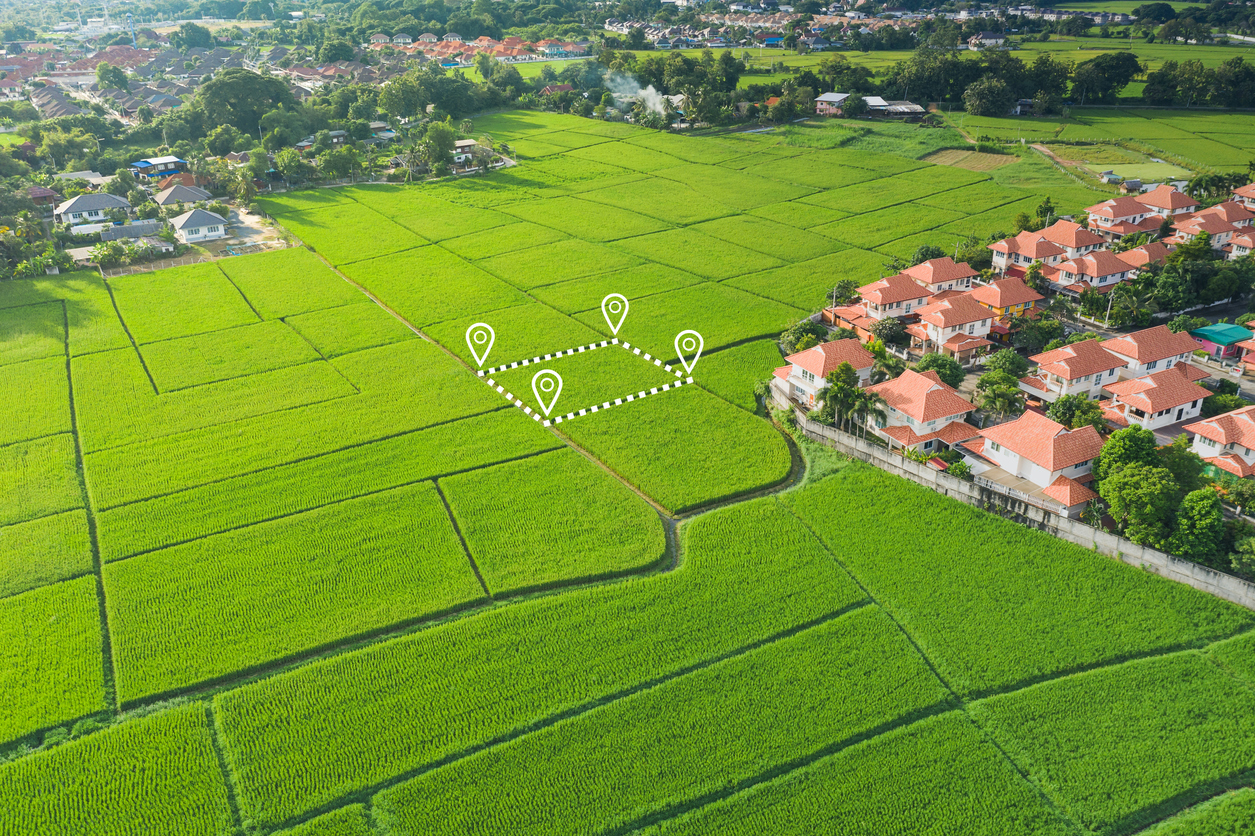We may earn revenue from the products available on this page and participate in affiliate programs. Learn More ›
Buying land to build a house is more complex than it might initially seem. For many, having a home built to their specifications is the culmination of many years of poring over house plan magazines and driving through neighborhoods looking at existing houses for design inspiration.
However, the building process is multifaceted, and the lot or land chosen for construction must meet certain specifications. Whether you long for a rural pastoral view with no neighbors in sight or you’re more interested in choosing a lot on a cul-de-sac, there are things to consider when buying land to build a house. The land you purchase lays the foundation for the entire construction process.
1. You may need to pay for the land in cash.
Mortgage lenders are less likely to loan money for raw, undeveloped land than for an existing house because there are too many unknowns with raw land. This is especially true for large plots of rural land because it can be cost-prohibitive in many cases to bring electrical power to the site and make provisions for a driveway, potable water, and a suitable sewer system.
The upside is that if you can pay for the land in cash, the lender is more likely to finance the construction of a new house. Suppose you own the land or lot outright (without a loan). In that case, the lender may consider your ownership as a down payment for construction financing, which can later be transferred into a traditional mortgage at the end of the building process.
The exception to this general rule is when you purchase a lot in a residential development where homes are currently under construction because the lender knows the developer has already taken care of the technical details. With a suitable down payment (the amount can vary by lender), you may be able to finance a platted lot and the cost of building a house in a single construction loan that will later roll into a mortgage when the house is move-in ready.
Related: 10 of the Cheapest Places to Buy Land in the U.S.

2. Look for land, but hire a real estate agent before you make an offer.
Part of the fun and excitement of building a new house is finding just the right location, so go ahead and scour the internet for property listings, drive up and down neighborhoods, or look for land that’s coming up for sale at auction. But don’t make an offer or place a bid before you hire a real estate agent that knows the area. If you work with an agent, you’ll have certain protections, such as the ability to get out of the contract if the property isn’t suited for construction.
Suppose you spot a 5-acre tract that looks like a heavenly place to build your rural dream home, and it has a For-Sale-by-Owner sign in front. It’s just the location you’ve been looking for, and you’re anxious to buy it before someone else does. Rather than make an offer, call an agent and ask her about the property. A knowledgeable agent can often tell you whether the land is in a flood plain, whether rural water and electricity are available in that area, and what type of building restrictions are in place.
An agent can also write up an offer that lets you back out if the local building authority does not approve a permit to build a house or if you’re unable to secure financing to build. You’ll end up paying the agent’s commission when the transaction is complete, but it’s worth it not to get stuck with land you can’t build on.
3. Research the value of nearby homes.
Building a home is a major investment, but the value of the house you build can suffer if homes of lesser value surround it. Your house will be worth more if it’s of similar or slightly less value than the nearby houses. If your new home costs $500,000 to build, but the neighbor’s homes are valued closer to $250,000, you may have a tough time selling your home for what it’s worth. On the flip side, if you spend $300,000 to build your house, and nearby homes are valued at over $1,000,000, your house will be more attractive to buyers and bring a better price.
Related: How Much Does a Land Survey Cost?

4. Consider how much land you really need.
If you’re buying a lot within the city limits, odds are the lots will already come with restrictions on the size and type of house you can build. If you’re unsure whether a specific lot is suitable to build your dream home, contact the local zoning authority or homeowners association (HOA), if one exists. They can tell you whether the lot comes with covenants or other restrictions that will impact what you can build.
While the idea of having an oversized lot is appealing to many, consider whether you’ll have the extra time to keep it mowed, landscaped, and watered. This is even more important to consider when buying large parcels of rural land. Mowing a 5-acre lot is time-consuming if you don’t have a riding lawn mower or a tractor mower.
It may be tempting to purchase a large tract of land and then section it off for family members to build nearby, but that may not be possible. County regulations often control the ability to subdivide a property, and they may pose obstacles to your plans.
Related: How Much Does It Cost to Demolish a House?
5. Don’t buy raw land before knowing the potential pitfalls.
You might have found a wonderful spot for your new home, but if local zoning does not allow you to put in a driveway that connects to the main road, the land is virtually worthless as a building site. Discovering potential pitfalls is another area where hiring an agent familiar with the community is essential, but you should also do your own due diligence.
If you’re looking at buying raw land to build a house, drive down the nearby roads. A hog farm less than a mile away can make it difficult to enjoy your property if the wind shifts. If the ground is heavy clay, installing a septic tank and lateral sewer system may not be possible.
Zoning restrictions in some counties will not allow property owners to place a mobile home or a tiny home on the property. Others will not let homeowners do their own construction. Find out as much as possible about the land and the local building and zoning rules before you buy. Even if you’re looking at buying land to build a house later on, your investment won’t be worth much if you discover you can’t build.


